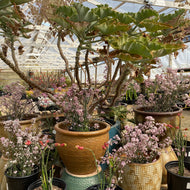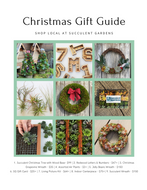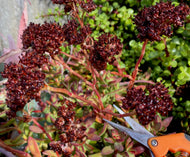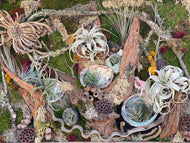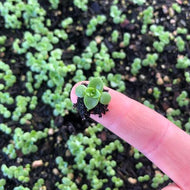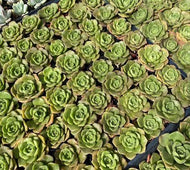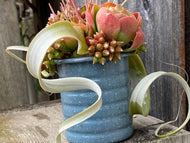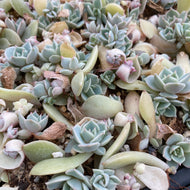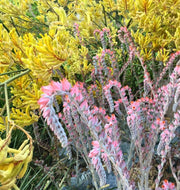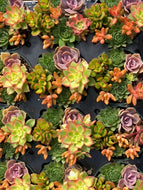The Globe, Succulent Gardens Make the World Go Round
designed, planted and grown by Robin Stockwell and the Succulent Gardens crew
in collaboration with Weston Cook and the San Francisco Flower and Garden Show.
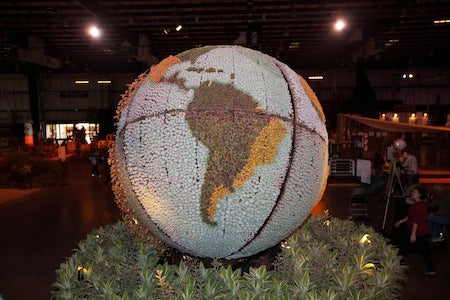
The Globe, Photo by Sara Shoemaker Lind
Click here to watch the time lapse video of the globe being built.
Click here to watch a video of the Globe spinning.
- Delivery to SF Garden show, 12 March 2013.
- Assembly 13 and 14 March.
- Show opens 20 March
1.) The all-steel Globe frame was manufactured by Bohl Ironworks with design input from Robin Stockwell.
2.) 8 sections needed to be customized to hold sphagnum for planting--about 8 bales.
3.) Hardware mesh was used to hold the sphagnum against the outer expanded metal skin of the Globe. About 72 hours of work was needed to install the sphagnum.
4.) A template was made to create the continents and oceans to scale. The template was the work of Joe Roubal, a professional Globe maker in southern California.
5.) The template arrived in 16, 2’ by 8’ sections and had to be carefully cut and placed on the eight Globe sections, a challenging jigsaw puzzle tackled by Robin’s son in law, Steve Alberi.
6.) Robin used a small blow up globe to lay out the succulent cutting palette.
7.) It took the production crew about 200 hours to plant (not including prep time for cuttings).
8.) Planting was completed in late August 2012.
9.) About 30,000 cuttings were used.
10.) The eight sections will be connected at the show and mounted on an armature and will stand about 15' high.
11.) It will be powered by a motor and spin on an axis tilted at the same angle as the earth. Maximum speed will be two revolutions per minute.
12.) The eight sections, when assembled, will weigh about one ton.
Stand by for what the Globe will be doing after the garden show!
The Frame
The globe frame was designed and built by Bohl Ironworks.

The globe was built in eight sections. In addition, there is the framework on which the globe will be mounted and a motor to power the rotation. The frame arrived in a tractor trailer and we unloaded it and moved it into the nursery.

Weston Cook and Robin Stockwell on the day the globe frame was delivered to the nursery:

It took about 1 and 1/2 bales of sphagnum moss per section, or a total of about 12 bales to fill the globe with enough planting medium.

The sphagnum moss was laid out in a thickness of about 2" and hardware mesh was wired on to keep the sphagnum in place.

The Map
I was fortunate to contact Joe Roubal, http://www.roubalmapping.com, who makes custom globes. He offered to make a template to scale for us to use to mark out the land masses on our Globe project. Once I had the template, I realized I was out of my league to put the puzzle together. After several days of avoidance, I realized I had a puzzle master in the family, my son-in-law, Steve. Steve agreed to put the puzzle together while I headed for the Trinity Alps on a back pack getaway. The entire template was comprised of 16 - 2'x8' sheets of paper. Steve cut up the template and laid it out on the globe, using screws to hold it in place temporarily.


The Plants
My production crew spent a week planting the globe. The cuttings were prepared the previous week. I used the small blow up globe, shown in the background, to mark which varieties I wanted used to represent the different oceans and land masses. There were about 30,000 cuttings. We used Echeveria secunda, Echeveria pulidonis-derenbergii hybrid, Echeveria subsessilis, Echeveria secunda 'Blue Mist' and Sedum dasyphyllum for the oceans. For the land masses we used Sedum nussbaunianum in the drier regions of the world. For the frozen areas we used Sedum spathulifolium 'Cape Blanco' and Echeveria elegans. For other areas of the land masses, I used a combination of Sempervivums, Crassulas, and Sedums.

After the cuttings were planted, we checked the globe daily to look for cuttings that had fallen out, probably from earths vibrations. After all of the cuttings had formed roots, we added Sedum dasyphyllum to enhance the look of the oceans.

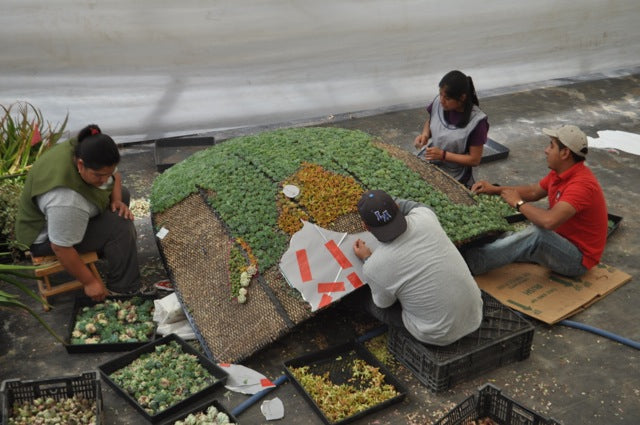
While everyone was enjoying the Extravaganza Speakers' tent, the world was growing and rooting nearby behind a wall of greenhouse poly. Before Christmas we started the final preparations to allow the globe to finish growing before the Flower Show.
After all of the cuttings were fully rooted and the plants were beginning to grow, we moved the globe to an area with more sunlight. This will allow the plants to harden, increase color, and grow more compactly. I may move the sections one more time to an outdoor location for a bit more hardening off.


We look forward to installing the Globe at the 2013 San Francisco Flower and Garden Show March 20-24.

